-
EngineAC Synchronous Permanent Magnetic Motor
-
Power66 HP / 49kW
-
TransmissionSingle Speed
-
Top Speed80 MPH
-
DrivetrainRear-Wheel Drive
-
Curb Weight2,579 LBS
-
Seating2+2
-
Cargo13.2 / 50.4 CU-FT
-
MPG126 City / 99 HWY MPGe
Light Weight, Rear-Wheel Drive And Instant Torque Bubble Up
There are two simple truths about the Mitsubishi i that should help this funky little electric car sell well in the U.S. once it goes on sale later this year. First, it looks like absolutely nothing else on the road today. Second, the car is much more fun than its jellybean shape implies.
The North American-spec i does share its look with versions on sale in Japan and Europe, but this EV is a different beast compared to those models. It's also completely different from the gas-powered kei-car sold only in Mitsubishi's home market, which was named the Japan Car of the Year by the Automotive Researchers' and Journalists' Conference in 2007. It's also completely different from the Japan or Euro-spec electric i-MiEVs (which are also slightly different from each other) that Mitsubishi has been showing off in the U.S. for the past few years. We've had a chance to drive these other models, and you can read our thoughts on the foreign i-MiEV here and here. At this point, though, it's best not to bother – this i is something new.
That's part of the idea, since the i is meant to be distinctive. Love it or hate it, Mitsubishi thinks that this is what electric car buyers want: an electric vehicle that looks like an electric vehicle, even if it comes from gas roots.
One of Mitsubishi's defining design parameters for this vehicle was a focus on simplicity. This is obvious as soon as you see the car and its sparse-feeling dashboard. Simplicity, however, means there has been some clever thinking done to improve the car for its U.S. introduction. Mitsubishi has beefed up the i's size and the performance of its all-electric powertrain. The car is 4.3 inches wider and 8 inches longer, for example, though the wheelbase is the same as other i models. The calibration of the electronic control unit is also specific to this market. And, not that EV buyers pick their plug-in vehicles based on safety concerns, but the U.S. i also adds side curtain airbags for the first time.
These look like small changes on paper, but behind the wheel, they make a huge difference.
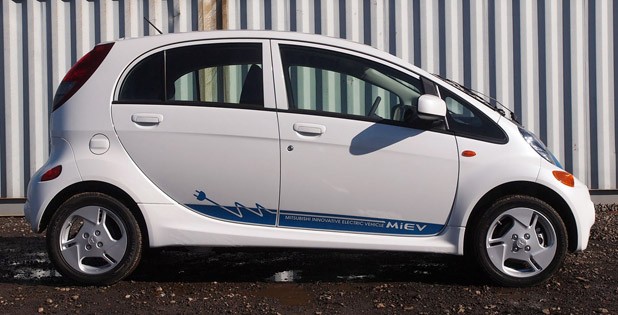
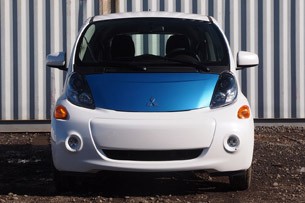
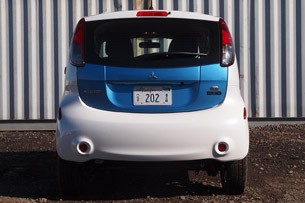
In our first drive of the i-MiEV, all the way back at the 2008 New York Auto Show, we wrote, "Make no mistake: the i MiEV is not quick in any sense, but the power on tap is perfectly suited to city driving." Today, with all its various improvements, we can say the new i is, well, quick. It's not quick like a Tesla Roadster, but it'll do just fine zipping onto the highway and darting about in the city. We found this out after spending an afternoon with a pre-production model in Portland, Oregon.
The i's three drive modes – Eco, D and B – remain nominally the same as before, but they have been tweaked. Eco, as should be familiar to many plug-in and hybrid drivers, prioritizes efficiency and longer range over dynamic performance, while D operates the way a standard gas engine would and is suitable for going up hills. It's the B mode, though, that's been changed the most. It now has much more regenerative brake power to accommodate one-foot EV driving, if that's your thing. Interestingly, B mode is also the most fun, with the interaction between driver and car feeling a bit like the connection that some find in manual transmission cars. You can't directly dial-in the regen braking level, but you can approximate it by cycling through the three modes. We were happy to discover that you can also shift into Neutral on long downhills for regen-free coasting, and we like the slight parking lot creep as well.
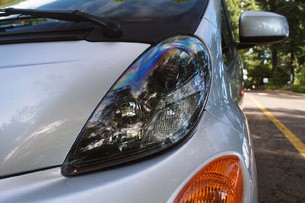
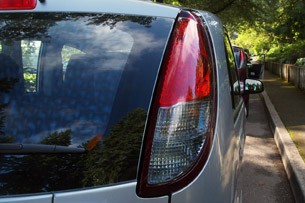
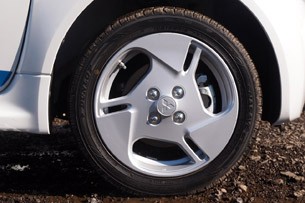
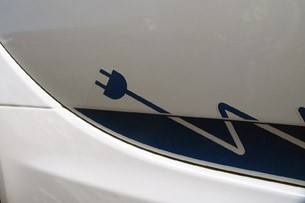
When you're not paying attention to the powertrain, you've got to watch the road for fun curves. For this, the i's wider stance helps with handling, but it's no mountain goat. Still, when you put all of the improvements together with the i's small size, low center of gravity (the 500-pound battery is part of the 600-pound penalty that the electric i has over the gas-powered version) and rear-wheel-drive powertrain, you've got an EV that's more fun than it should be, especially given its skinny tires. We'll call it "suitable fun."
For instance, the i has 16 bars in its battery state-of-charge gauge. When the gauge gets down to two bars, the low battery lights comes on. When there's five percent usable energy left, a turtle light comes on. At three percent, the car goes into limp mode, which gives the driver just a few miles of range left at low speeds to get to an outlet. Since the i only uses around 92 percent of its 300-volt, 16-kWh, 500-lb. battery to preserve the pack's life, when the car tells you it's at "zero," it's really at about eight percent from empty.
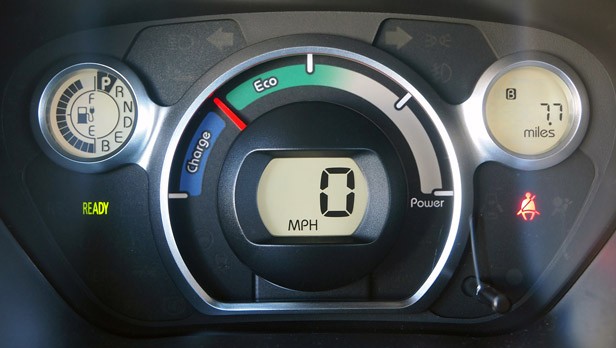
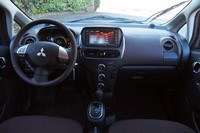
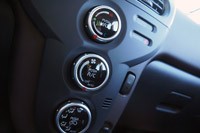
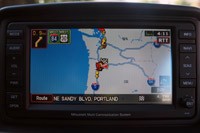
The spartan dashboard isn't completely useless, of course. It does have a digital speedometer surrounded by a charge/eco power meter. The goal, if you're going for efficiency, is to keep it in the "eco" range, since the white zone indicates when you're using more energy. Taking your foot off the pedal puts the car into the charge zone. How do you keep it in eco? By being sensible: Keep a consistent speed, let the car decelerate without hitting the brake whenever possible, use momentum to crest uphills when possible, preheat or precool the car when it's plugged into the grid (if you're already on the road, use the standard seat heater instead of heating the cabin) and so on.
Speaking of plugging in, what about the battery? Made up of 88 3.7V cells arranged into 22 modules, the pack is waterproof and wrapped in a stainless steel case designed to protect the system in a crash. Using a standard 120-volt outlet, the pack will take a whopping 22.5 hours to charge from empty. However, this drops to just seven hours using a 240V EVSE, and i models equipped with CHAdeMO capability will take just 20-30 minutes to get to 80 percent full. No announcement has been made about possible car-to-home charging in the U.S., but we have to assume this technology will make the jump across the pond.
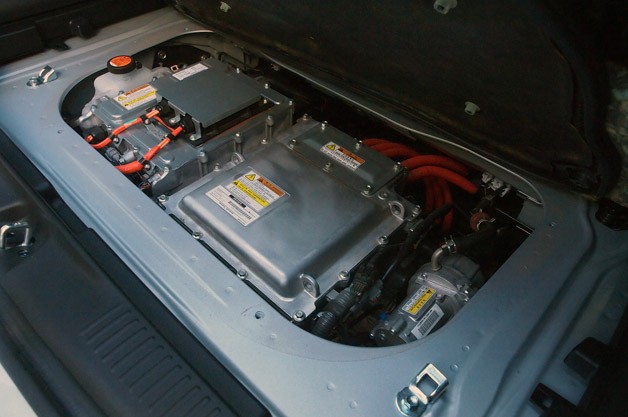
The pack is air-cooled using forced induction, which means that an exhaust fan pulls hot air through the pack. When the pack is above 68 degrees Fahrenheit, the fans blow ambient air through the battery. If that's not enough and the pack gets above 86 degrees, the car's air-con unit will automatically turn on and force cooled air through the pack. This won't happen very much, apparently, but quick-charging will often raise the temperature above 86 degrees – even if Mitsubish says that daily quick-charging is not a problem for this car.
The rest of the powertrain is just as well sorted. The small, 101-pound maintenance-free motor is waterproof, has a dust-resistant casing and offers 9,900 maximum rpm along with that one joyous benefit of EVs: instant torque. The just-as-small transmission weighs only 42 pounds. The powertrain has a five-year, 60,000-mile warranty and the battery is warranted for eight years or 100,000 miles. All this technology gives Mitsubishi bragging rights to an EPA rating of 112 mpge, and it should be good for a maximum of 98 miles on a charge. Mitsubishi itself is being a bit more conservative, suggesting that drivers should expect around 85 miles out of a full pack, even though the Monroney is going to say this little bubble has a range of 62 miles.
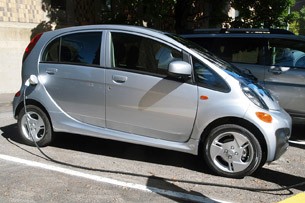
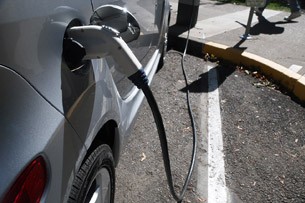
How does that work? Well, the EPA measures electric vehicles using a two-cycle (city/highway) test and then subtracts 30 percent from these numbers to approximate "real world" driving. 70 percent of the i's city range (98 miles) is 69 miles. 70 percent of the car's highway range (78 miles) is 55 miles. In calculating a combined (city/highway) driving range, the EPA weighs the formula slightly more in the favor of the city range (55 percent) versus the highway range (45 percent), thus: (98 miles at 55 percent) + (78 miles at 45 percent) x 70 percent = 62 miles. That may make some sort of regulatory sense, but there should no longer be any doubt that your mileage may vary when it comes to EV range estimates.
Another simple solution Mitsubishi uses with the i is its bizarre remote key fob. This non-Internet-connected device can communicate wirelessly with the vehicle (if within range) to pre-heat or pre-cool the vehicle, as well as set the charging process. We think the fob is too big and does too little – and carrying another digital piece of plastic is annoying – but company spokesman Maurice Durand reminds AutoblogGreen that Mitsubishi is really dealing with a car that's three years old at this point, and the fob was the simplest solution without adding cost. We hope that a smart-phone solution will be coming at some point.
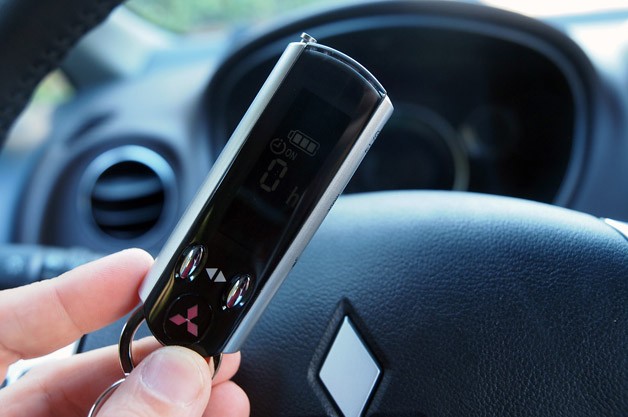
There are some similarities with the original i and i-MiEV models. For instance, the interior is much bigger than you expect it to be, and tall passengers will fit comfortably in front or back. When the rear seats are folded down, the i offers over 50 cubic feet of cargo room, accessed through an expansive rear opening.
There is one thing where the U.S.-spec i really, truly needs to be changed. The gear identifiers are on the right side of the shifter stalk, exactly opposite of where they should be. This is a holdover from the car's Japanese origin, but the small gear indicator on the dash is not easy enough to see to replace the big white letters on the shifter itself. Little quirks like these make you wonder, since you'd think that Mitsubishi would know what it's doing when it comes to EVs by now. The company's first EV was the Mini Cab EV, which was made way back in 1966. Mitsubishi also made the Minica EV in 1971. It was powered by heavy lead acid batteries, but it was followed by Mitsu's first li-ion battery car, the FTO EV, in 1999. Ah, well.
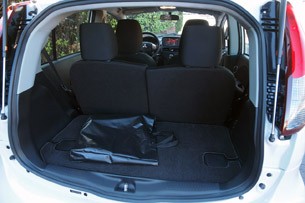
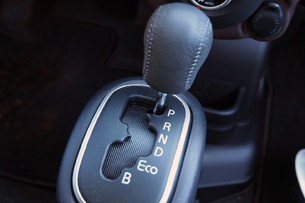
We'll know soon enough whether these minor problems keep buyers away from the i. The first deliveries will happen in four rollout states – California, Oregon, Washington and Hawaii – in early 2012. While all 400 Mitsubishi dealers nationwide will get ads for their showrooms to highlight the differences between gas and electric vehicles in the third quarter of 2011, about 75 percent of the roughly 40 Mitsubishi dealers in the rollout states will be i certified (with more to come). On top of the information sent to everyone, certified dealers will get three vehicle chargers, a drop-down i sign and an Apple iPad loaded with i information. By the end of November or early December, all certified dealers will also get (read: have to purchase) two i vehicles, one for display and one for demo drives. So, that's 60 units sold right there. The i will be available nationwide by the end of 2012.
Originally, the before-rebate cost for the entry-level ES version was going to be $27,990, but "unforeseen" changes (i.e., a stronger yen) caused this to climb up to $29,125 ($21,625 after tax credit). The top-of-the-line SE with Premium package, which includes CHAdeMO quick charging capability, will command $33,915 ($26,415 after tax credit). On top of the car's MSRP, Mitsubishi is partnering with Best Buy's Geek Squad to install $700 Eaton home chargers (plus installation fees).
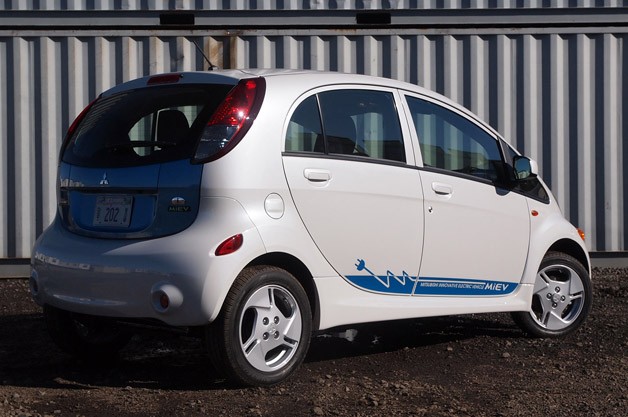
As these prices imply, Mitsubishi is not trying to make a luxury electric car here. Instead, it is trying to make the most affordable EV in the U.S. – the opposite of the Tesla plan. Mitsubishi representatives tell us that the company feels low costs are important to encourage electric vehicle adoption, especially for the target demographic. Mitsubishi estimates sales of 1,500 in the first fiscal year (through March 31, 2012) and then 3,000 to 5,000 in the second fiscal year (April 2012 – March 2013). So far, Mitsubishi has gotten around 400 i pre-orders through its website.
Mitsubishi may have a bit of a sleeper hit on its hands, too. We know that first-gen EVs are not for everyone, but the pace of change in this category means the EV that's right for you may be here sooner than you realize. In fact, if none of this sounds that exciting to you, but you really wanted to like the i, don't worry. Mitsubishi reps have told us that the next-gen model is not far away.
There are two simple truths about the Mitsubishi i that should help this funky little electric car sell well in the U.S. once it goes on sale later this year. First, it looks like absolutely nothing else on the road today. Second, the car is much more fun than its jellybean shape implies.
The North American-spec i does share its look with versions on sale in Japan and Europe, but this EV is a different beast compared to those models. It's also completely different from the gas-powered kei-car sold only in Mitsubishi's home market, which was named the Japan Car of the Year by the Automotive Researchers' and Journalists' Conference in 2007. It's also completely different from the Japan or Euro-spec electric i-MiEVs (which are also slightly different from each other) that Mitsubishi has been showing off in the U.S. for the past few years. We've had a chance to drive these other models, and you can read our thoughts on the foreign i-MiEV here and here. At this point, though, it's best not to bother – this i is something new.
That's part of the idea, since the i is meant to be distinctive. Love it or hate it, Mitsubishi thinks that this is what electric car buyers want: an electric vehicle that looks like an electric vehicle, even if it comes from gas roots.
One of Mitsubishi's defining design parameters for this vehicle was a focus on simplicity. This is obvious as soon as you see the car and its sparse-feeling dashboard. Simplicity, however, means there has been some clever thinking done to improve the car for its U.S. introduction. Mitsubishi has beefed up the i's size and the performance of its all-electric powertrain. The car is 4.3 inches wider and 8 inches longer, for example, though the wheelbase is the same as other i models. The calibration of the electronic control unit is also specific to this market. And, not that EV buyers pick their plug-in vehicles based on safety concerns, but the U.S. i also adds side curtain airbags for the first time.
These look like small changes on paper, but behind the wheel, they make a huge difference.



In our first drive of the i-MiEV, all the way back at the 2008 New York Auto Show, we wrote, "Make no mistake: the i MiEV is not quick in any sense, but the power on tap is perfectly suited to city driving." Today, with all its various improvements, we can say the new i is, well, quick. It's not quick like a Tesla Roadster, but it'll do just fine zipping onto the highway and darting about in the city. We found this out after spending an afternoon with a pre-production model in Portland, Oregon.
There is no official time for a trip from 0-60 just yet, but the electric motor is quicker and provides slightly more horsepower (three, to be exact, for a total of 66) than the Japanese Domestic Market version, enough to accelerate to 50-60 mph with spunk. Mitsubishi says that 30-35 mph is the "ideal speed" for electric cars and they're perfectly suited for urban environments, but when let loose in this venue, the i offers more fun than should be expected with a small EV – as long as you have its settings just right.The i offers more fun than should be expected with a small EV.
The i's three drive modes – Eco, D and B – remain nominally the same as before, but they have been tweaked. Eco, as should be familiar to many plug-in and hybrid drivers, prioritizes efficiency and longer range over dynamic performance, while D operates the way a standard gas engine would and is suitable for going up hills. It's the B mode, though, that's been changed the most. It now has much more regenerative brake power to accommodate one-foot EV driving, if that's your thing. Interestingly, B mode is also the most fun, with the interaction between driver and car feeling a bit like the connection that some find in manual transmission cars. You can't directly dial-in the regen braking level, but you can approximate it by cycling through the three modes. We were happy to discover that you can also shift into Neutral on long downhills for regen-free coasting, and we like the slight parking lot creep as well.




When you're not paying attention to the powertrain, you've got to watch the road for fun curves. For this, the i's wider stance helps with handling, but it's no mountain goat. Still, when you put all of the improvements together with the i's small size, low center of gravity (the 500-pound battery is part of the 600-pound penalty that the electric i has over the gas-powered version) and rear-wheel-drive powertrain, you've got an EV that's more fun than it should be, especially given its skinny tires. We'll call it "suitable fun."
One area where Mitsubishi has skimped on details – we could be generous by saying the beancounters and engineers have kept the car's simplicity ethos intact – is on the information-sparse dashboard. All you see is a battery state-of-charge meter, a gear indicator, the speedometer, the eco/regen indicator and the odometer. Serious EV fans will want to know more.The 500-pound battery is the biggest part of the electric i's 600-pound penalty.
For instance, the i has 16 bars in its battery state-of-charge gauge. When the gauge gets down to two bars, the low battery lights comes on. When there's five percent usable energy left, a turtle light comes on. At three percent, the car goes into limp mode, which gives the driver just a few miles of range left at low speeds to get to an outlet. Since the i only uses around 92 percent of its 300-volt, 16-kWh, 500-lb. battery to preserve the pack's life, when the car tells you it's at "zero," it's really at about eight percent from empty.




The spartan dashboard isn't completely useless, of course. It does have a digital speedometer surrounded by a charge/eco power meter. The goal, if you're going for efficiency, is to keep it in the "eco" range, since the white zone indicates when you're using more energy. Taking your foot off the pedal puts the car into the charge zone. How do you keep it in eco? By being sensible: Keep a consistent speed, let the car decelerate without hitting the brake whenever possible, use momentum to crest uphills when possible, preheat or precool the car when it's plugged into the grid (if you're already on the road, use the standard seat heater instead of heating the cabin) and so on.
Speaking of plugging in, what about the battery? Made up of 88 3.7V cells arranged into 22 modules, the pack is waterproof and wrapped in a stainless steel case designed to protect the system in a crash. Using a standard 120-volt outlet, the pack will take a whopping 22.5 hours to charge from empty. However, this drops to just seven hours using a 240V EVSE, and i models equipped with CHAdeMO capability will take just 20-30 minutes to get to 80 percent full. No announcement has been made about possible car-to-home charging in the U.S., but we have to assume this technology will make the jump across the pond.

The pack is air-cooled using forced induction, which means that an exhaust fan pulls hot air through the pack. When the pack is above 68 degrees Fahrenheit, the fans blow ambient air through the battery. If that's not enough and the pack gets above 86 degrees, the car's air-con unit will automatically turn on and force cooled air through the pack. This won't happen very much, apparently, but quick-charging will often raise the temperature above 86 degrees – even if Mitsubish says that daily quick-charging is not a problem for this car.
The rest of the powertrain is just as well sorted. The small, 101-pound maintenance-free motor is waterproof, has a dust-resistant casing and offers 9,900 maximum rpm along with that one joyous benefit of EVs: instant torque. The just-as-small transmission weighs only 42 pounds. The powertrain has a five-year, 60,000-mile warranty and the battery is warranted for eight years or 100,000 miles. All this technology gives Mitsubishi bragging rights to an EPA rating of 112 mpge, and it should be good for a maximum of 98 miles on a charge. Mitsubishi itself is being a bit more conservative, suggesting that drivers should expect around 85 miles out of a full pack, even though the Monroney is going to say this little bubble has a range of 62 miles.


How does that work? Well, the EPA measures electric vehicles using a two-cycle (city/highway) test and then subtracts 30 percent from these numbers to approximate "real world" driving. 70 percent of the i's city range (98 miles) is 69 miles. 70 percent of the car's highway range (78 miles) is 55 miles. In calculating a combined (city/highway) driving range, the EPA weighs the formula slightly more in the favor of the city range (55 percent) versus the highway range (45 percent), thus: (98 miles at 55 percent) + (78 miles at 45 percent) x 70 percent = 62 miles. That may make some sort of regulatory sense, but there should no longer be any doubt that your mileage may vary when it comes to EV range estimates.
Another simple solution Mitsubishi uses with the i is its bizarre remote key fob. This non-Internet-connected device can communicate wirelessly with the vehicle (if within range) to pre-heat or pre-cool the vehicle, as well as set the charging process. We think the fob is too big and does too little – and carrying another digital piece of plastic is annoying – but company spokesman Maurice Durand reminds AutoblogGreen that Mitsubishi is really dealing with a car that's three years old at this point, and the fob was the simplest solution without adding cost. We hope that a smart-phone solution will be coming at some point.

There are some similarities with the original i and i-MiEV models. For instance, the interior is much bigger than you expect it to be, and tall passengers will fit comfortably in front or back. When the rear seats are folded down, the i offers over 50 cubic feet of cargo room, accessed through an expansive rear opening.
There is one thing where the U.S.-spec i really, truly needs to be changed. The gear identifiers are on the right side of the shifter stalk, exactly opposite of where they should be. This is a holdover from the car's Japanese origin, but the small gear indicator on the dash is not easy enough to see to replace the big white letters on the shifter itself. Little quirks like these make you wonder, since you'd think that Mitsubishi would know what it's doing when it comes to EVs by now. The company's first EV was the Mini Cab EV, which was made way back in 1966. Mitsubishi also made the Minica EV in 1971. It was powered by heavy lead acid batteries, but it was followed by Mitsu's first li-ion battery car, the FTO EV, in 1999. Ah, well.


We'll know soon enough whether these minor problems keep buyers away from the i. The first deliveries will happen in four rollout states – California, Oregon, Washington and Hawaii – in early 2012. While all 400 Mitsubishi dealers nationwide will get ads for their showrooms to highlight the differences between gas and electric vehicles in the third quarter of 2011, about 75 percent of the roughly 40 Mitsubishi dealers in the rollout states will be i certified (with more to come). On top of the information sent to everyone, certified dealers will get three vehicle chargers, a drop-down i sign and an Apple iPad loaded with i information. By the end of November or early December, all certified dealers will also get (read: have to purchase) two i vehicles, one for display and one for demo drives. So, that's 60 units sold right there. The i will be available nationwide by the end of 2012.
Originally, the before-rebate cost for the entry-level ES version was going to be $27,990, but "unforeseen" changes (i.e., a stronger yen) caused this to climb up to $29,125 ($21,625 after tax credit). The top-of-the-line SE with Premium package, which includes CHAdeMO quick charging capability, will command $33,915 ($26,415 after tax credit). On top of the car's MSRP, Mitsubishi is partnering with Best Buy's Geek Squad to install $700 Eaton home chargers (plus installation fees).

As these prices imply, Mitsubishi is not trying to make a luxury electric car here. Instead, it is trying to make the most affordable EV in the U.S. – the opposite of the Tesla plan. Mitsubishi representatives tell us that the company feels low costs are important to encourage electric vehicle adoption, especially for the target demographic. Mitsubishi estimates sales of 1,500 in the first fiscal year (through March 31, 2012) and then 3,000 to 5,000 in the second fiscal year (April 2012 – March 2013). So far, Mitsubishi has gotten around 400 i pre-orders through its website.
If sales in Europe and Japan are anything to go by, the i should sell just fine in the States. The i-MiEV was introduced to the market in July of 2009 and has already sold around 11,000 units. It's important to note that that's just the Mitsubishi version, since both Peugeot and Citroën have been selling rebadged versions in Europe since 2010. Bryan Arnett, Mitsubishi Motors North America's manager of EV product strategy, said that the i is the "most-proven mass production electric vehicle available today. We feel very confident bringing the U.S.-spec version of the car to the United States."Mitsubishi may have a bit of a sleeper hit on its hands.
Mitsubishi may have a bit of a sleeper hit on its hands, too. We know that first-gen EVs are not for everyone, but the pace of change in this category means the EV that's right for you may be here sooner than you realize. In fact, if none of this sounds that exciting to you, but you really wanted to like the i, don't worry. Mitsubishi reps have told us that the next-gen model is not far away.
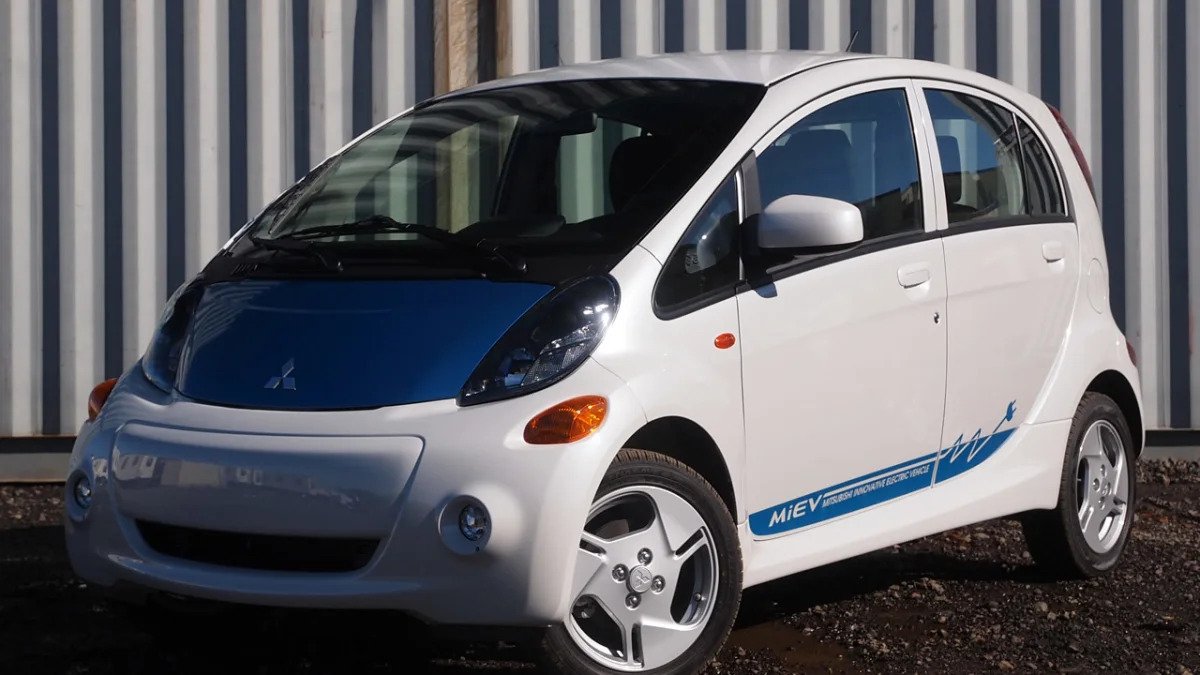









Sign in to post
Please sign in to leave a comment.
Continue